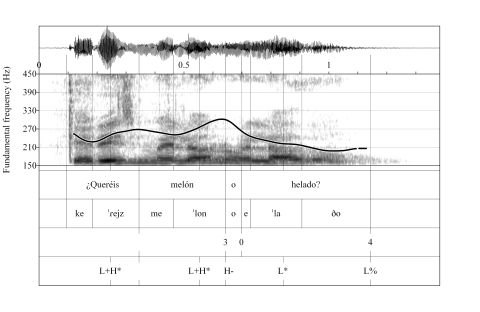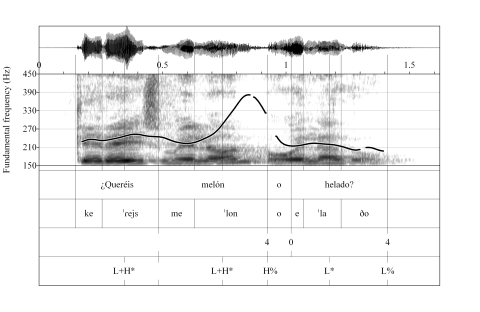There are some phenomena which may appear within an intonational phrase (IP) but not accross different IPs. So, on the one hand, a BI 4 inhibits the application of many sandhi rules. On the other hand, a BI 4 is accompanied by rhythmic cues: it is the domain for pre-boundary lengthening, and it defines the position for pauses. Finally, it has a precise intonational definition. The IP is the domain of the minimal tune: it consists of one or more pitch accents plus boundary tones. Thus, a BI 4 is always accompanied by the presence of boundary tones.
There are several arguments in favor of a level for an intonationally-defined constituent underneath the intonational phrase: the intermediate phrase (ip).
The first argument is a perceptual one. In Spanish prosodic transcriptions, transcribers clearly distinguish between two degrees of perceived disjuncture. The end of the weaker disjuncture corresponds to a level 3 break index in the ToBI system, while the strong disjuncture corresponds to a level 4 break index.
The second argument relates to intonational marking. Like the intonational phrase, the intermediate phrase is tonally marked after its final pitch accent (yet not as strongly as the intonational phrase), but the inventory of boundary tones that appear in this position is of a different (but partially overlapping) class. Typically, H- boundary tones, also called continuation rises, mark the end of an intermediate phrase.
Frota, D'Imperio, Elordieta, Prieto & Vigário (2007) examined the phonetics and phonology of prosodic boundaries in such positions in five Romance languages, Spanish among them. They found that the two dominant boundary tones in statements (located at the end of the first prosodic constituent) were either the continuation rise or the sustained pitch. By contrast, intonational phrase-final edges were generally signaled by a low boundary tone (L%) and by a wider inventory of boundary tone combinations.
BI 3
Break indices of level 3 (BI 3) correspond to the end of minor prosodic units: they mark the boundaries of intermediate phrases (ips).
BI 4
Break indices of level 4 (BI 4) correspond to the end of major prosodic units: they mark the boundaries of intonational phrases (IPs).
Example BI 3
Example BI 4
¿Queréis melón o helado?
[Do you want some melon or ice cream?]

¿Queréis melón, o helado?
[Do you want some melon, or ice cream?]

